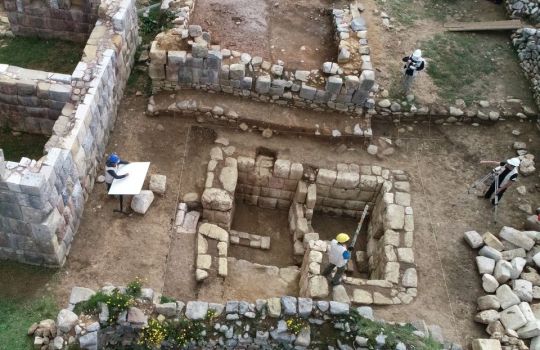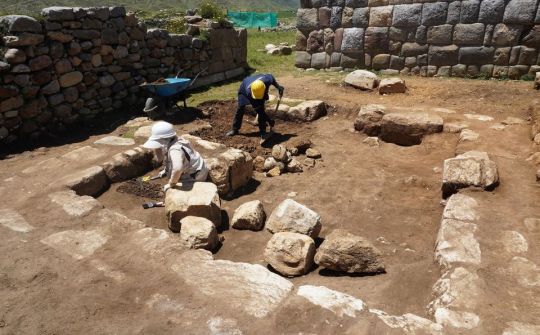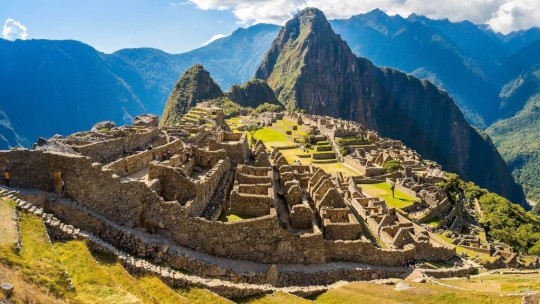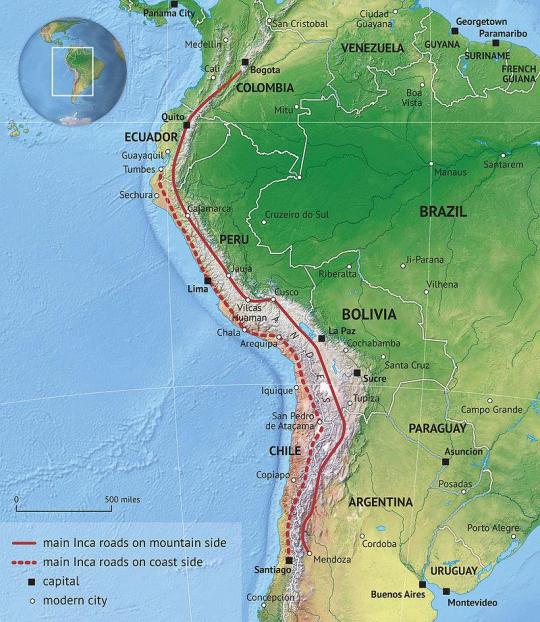#Qhapaq Nan
Explore tagged Tumblr posts
Text
Explore la antigua maravilla de los correcaminos de relevo Inca Chasqui, veloces mensajeros que corrían todo el día y toda la noche para transmitir mensajes por todo el vasto reino inca. El sistema revolucionó las comunicaciones en el corazón de los Andes y sirvió como testimonio del ingenio y la organización del Imperio Inca.
0 notes
Photo




Peruvian Archaeologists Unearth 500-Year-Old Inca Ceremonial Bath
Archaeologists in the Peruvian Andes have discovered an Inca bathing complex built half a millennia ago, which they believe may have served the elite of the sprawling empire than once dominated large swathes of South America.
Found near the "House of the Inca" in the Huanuco Pampa archaeological zone in central Peru, local archaeologists believe that the bath may have served a religious purpose for high-ranking members of the Inca empire, which 500 years ago extended from southern Ecuador to the center of Chile.
Luis Paredes Sanchez, project manager at Huanuco Pampa, said the structure was similar to "more hierarchical, restricted and sacred spaces within the Inca administrative centers, because rather than having a utilitarian or hygienic function, they also served for religious functions and worshiping ancestors."
The "finely carved" bath averages some two-meters in depth, with independent pools and spillways and a central passage taking water into a drainage duct that divides the room into two small platforms, or "benches" for the Inca, Peru's culture ministry said in a statement.
The Huanuco Pampa archaeological site is part of the Qhapaq Nan project, a complex 25,000-kilometer-long road network that linked Ecuador, Colombia, Peru, Bolivia and Argentina. The road system was declared a World Heritage Site in 2014.
Peru is home to hundreds of archaeological sites across the country, including the Machu Picchu citadel in the Inca capital of Cusco, and the Nasca lines, massive designs drawn in Ica's coastal desert region over 1,500 years ago.
#Peruvian Archaeologists Unearth 500-Year-Old Inca Ceremonial Bath#House of the Inca#Huanuco Pampa archaeological zone#inca#Inca empire#ancient artifacts#archeology#archeolgst#history#history news#ancient history#ancient culture#ancient civilizations#Inca history
138 notes
·
View notes
Photo

Qhapaq Ñan. It is the most widespread World Heritage Site in Latin America since it is shared by 6 countries.
250 notes
·
View notes
Text
Inca Trail: the most famous trek in Peru
heard about the Inca Trail, an unforgettable walk! The Inca Trail 4 days is the most famous trek in Peru, it is an unforgettable trek that it deserves, since it is listed as a UNESCO World Heritage Site, only 500 people have the opportunity to practice each one. day in Peru, and you have to reserve your place very, very much in advance. Supply less than demand, the price is now quite high. The Inca Trail or "Inca Trail" that leads to Machu Picchu hike is only a small section of the Qhapaq Ñan, the "Great Road" in Quechua, a network of more than 40,000 km that crosses the Andes and the Pacific coast to the south from present-day Colombia to the northernmost limit of the empire south of what is now Santiago de Chile.
The Qhapaq Ñan crosses 6 countries in South America in almost 6,000 km. It crosses Colombia, the equator, Peru, Bolivia, Chile and Argentina. If Peru attracts the largest number of tourists on the Inca trail, it is because it is lucky to have the best preserved section, almost 80 km, with forts throughout the trek. , post offices, temples, "tambo" (you could almost say the stops and service stations along the way!) agricultural terraces, bridges and numerous structures of which only a few vestiges remain.
Inca Trail: a bit of history
The Inca road network was born from the merger of all the roads traced by the various pre-Columbian civilizations, previous to the Incas, such as the civilizations, Mochica, Chavín, Caral, Nazca, etc. The Wari culture would have made a first reunification of all these routes in an enormous network of communication routes. The Incas only had to strengthen the roads, reconnect, consolidate and protect them to build their colossal empire. The main axis of the Inca trail is 6000 kilometers, a path that begins in San Juan de Pasto in Colombia, south of Santiago de Chile! It is thanks to this path that the Incas were able to establish their economic and political power, with the capital Cuzco at its center, the navel of the Inca empire.

It is difficult to imagine what Qhapaq Ñan represents, it is not just a simple trail in the middle of the mountains ... In some places, it is more than 20 meters wide, it winds through the valleys to connect the cities. , temples, mines, etc. and its altitude can go from 800 to 5000 meters. The Incas have in certain vast sections paved with rocks, huge stairs carved into the mountainside, etc. The network brings together a set of structures unique in the world.
Today it is necessary to improve the Qhapaq Nan and protect it from the wear of time, natural erosion and especially from the impact of man. It is important to maintain this route, which allowed the unification of all Andean cultures and which gave rise to one of the most majestic cultures in the world and, without a doubt, the best administratively organized at that time. , compared to those in Europe.
The Inca Trail in Peru, the best preserved part! Peru is fortunate to have the sections in the best state of conservation of all the Qhapaq Ñan. One of the most beautiful sections, over 80 kilometers between Huari and the second largest city in the Inca empire Huánuco Pampa, it is simply wonderful for anyone interested in the history of Andean civilizations. You can see paved roads, bridges, ruins, channels, etc.
There are many sections in good condition in the Lake Titicaca region and we have discovered one in which we are the only ones who take visitors there. The Qhapaq Ñan de Collasuyu passed through the great temple of Wiracocha near the town of Raqchi and it is possible to travel one kilometer near the temple site. There is also a very beautiful section of the royal road that led to the palace of the Emperor Wiracocha Inca in Huchuy Qosqo. Another very beautiful section leads from Chinchero to the Sacred Valley in the town of Urquillos. The most beautiful classic Inca trail and, without a doubt, the longest is the one that allowed dozens of Andean pilgrims to descend on the coast to the great religious complex of Pachacamac, near Lima. Small vestiges that allow us to imagine the magnitude of
Finally, the four stages of the "Inca Trail" in Peru. The 40 kilometers that, from the Sacred Valley, take you directly to the site of Machu Picchu tours built during the reign of Pachacutec, around 1440, are simply magical. These routes are now more effectively protected by the Peruvian government and classified by UNESCO to prevent deterioration and allow a limited number of privileged visitors to travel them. and immerse yourself in the heart of the Inca civilization walking to its most emblematic city: Machu Picchu.
0 notes
Text
The Qhapaq Ñan: Ancestral Inca Trail To Machu Picchu
The Qhapaq Ñan: Ancestral Inca Trail To Machu Picchu
The Qhapaq Ñan, is the word that defines the road system of the Inca Civilization and is definitely the best material test, which can give us an idea of the magnitude of this empire, becoming one of the greatest achievements in indigenous America. An estimated 23 thousand km is calculated, although other studies say that up to 40 thousand km could be registered, from an extensive network of…
View On WordPress
#camino inca#camino inka#Cusco#cusco andean tours#INCA TRAIL#inka trail#Machu Picchu#Peru#TREK TO MACHU PICCHU
0 notes
Text
The Qhapaq Ñan: ancestral paths of the Incas
The Qhapaq Ñan: ancestral paths of the Incas
The Qhapaq Ñan, is the word that defines the road system of the Inca Civilization and is definitely the best material test, which can give us an idea of the magnitude of this empire, becoming one of the greatest achievements in indigenous America. An estimated 23 thousand km is calculated, although other studies say that up to 40 thousand km could be registered, from an extensive network of…
View On WordPress
#amerika tours peru#INCA TRAIL#inca trail classic#incatrail#machu picchu#machu picchu trek#trek to machu picchu
0 notes
Text
The Inca Returns In Civilization VI: Gathering Storm
The Inca, a mainstay civ in previous Civilization games, returns for Civilization VI’s second expansion Gathering Storm.
While a few of the revealed new civs have unique setbacks like Canada cannot declare surprise wars and the Maori having no land at the start, the Inca plays more closer to the usual civs, with slight modifiers.
The Inca makes use of mountains and hills like no other civs can. Its unique ability Mita’a allows you to work mountain tiles, which usually is only useful for district bonuses when playing other civs. Putting your population to work on mountains yields production and also food if adjacent to The Inca’s unique improvement, terrace farms. This can be built on hill tiles and provide food and works best when adjacent to each other for more bonuses.
The Inca also has access to the Warak’aq, a unique recon unit that can attack twice as long as it does not use movement points in the same turn.
youtube
Leading The Inca is Pachacuti. His unique ability, Qhapaq Nan, will make your trade routes produce extra food for each mountain tile that exist inside the origin city’s borders. Pachacuti also allows The Inca to build the Qhapaq Nan, an early version of Mountain Tunnels so you can cross those mountains earlier than any civ.
The Inca works nice as an isolationist. Building internal trade routes should see your cities grow quickly and the fact that they are on high ground and surrounded by mountains means it’s hard to invade. On paper, this seems like a great civ to build tall (less cities, bigger population).
Civilization VI: Gathering Storm will be out on PC (Steam) on February 14th, 2019.
Source: Civilization
The Inca Returns In Civilization VI: Gathering Storm published first on https://touchgen.tumblr.com/
0 notes
Link
Awesome! Its about time.
0 notes
Text
New section of Inca road discovered in Arequipa, Peru

22 kilometers of previously unknown road have been uncovered in the Arequipa province of Caraveli.
5 notes
·
View notes